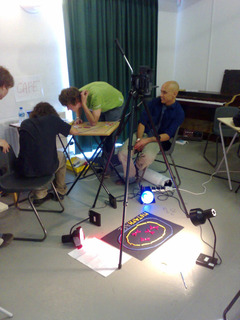Gear — Accessories
You don’t need anything other than a camera (and you may not even need that, if you’re making an animated film), but this stuff will help you achieve better results:
Tripods
Saying ‘hold the camera still’ to an excited SciCast film-maker is like trying to train custard to flow uphill. It’s best to attach a weighty boat anchor of a tripod to the camera in the hopes they’ll get the hint. A few notes on things to look for:
- If you’re buying a tripod, look for a video tripod, which you can pan and tilt smoothly, rather than a stills tripod, which locks off solidly. If the shop you’re in doesn’t know the difference, try another shop.
- ‘Lightweight’ is not a phrase you want to hear. But don’t buy something so heavy teenagers can’t lift it.
- A decent tripod will cost you between £50 and £100; more expensive ones are designed for heavier semi-professional cameras. Cheaper ones are usually too flimsy to be of much use.
- Be aware of safety issues: tripods are significant trip hazards, and there are manual handling worries too. They’re awkward things to carry, and offer lots of painful finger-traps.
It’s worth looking at what might seem like odd solutions. Monopods, for example, are like walking-sticks with a ball-head on them into which you can screw your camera. They’re not as stable as tripods, but they’ll hold the camera more steady than most 14 year-olds. You might also take a look at Gorillapods and other weird clamp-type arrangements; a little ingenuity can really work wonders.
Wide-angle adaptors
A common flaw of cheap cameras is that the lens doesn’t zoom out wide enough. To include both a person and the experiment they’re doing on a table, you have to stand back halfway across the room.
One option is to look carefully at your camera’s lens, and see if there’s a screw thread surrounding it. If so, you may be able to fit a wide- angle adaptor: an accessory lens that gives you a wider field of view. These tend to be optically rather poor, so take your camera to the shop and test out a few different models, if you can. Make sure your camera can still focus, that the corners of the picture don’t go terribly dark (‘vignetting’), and see how distorted the picture looks: doors and walls will usually bow out or ‘pincushion’. The question is: how distracting is the effect?
If you can find one that’s even half-decent, the extra versatility may be well worth the money.
Spare batteries
Cameras eat batteries. On the other hand, SciCast films are short, and you’ll typically shoot around ten minutes of material for each. So unless your battery’s really past its prime, you should be OK.
Lights
To be honest, we usually don’t bother. Lighting for video is, as far as we’re concerned, a complete black art, and far more bother than it’s worth. Not to mention the risk of tripping over stands and cables. However, if you have theatrical lights kicking around in school anyway, and you want to make a bit of a production of it, who are we to stop you?
The picture to the right is of an early SciCast workshop, where one team made a terrific plasticene animation about cell mitosis. You can see they’ve used three desk lamps to light their ‘stage’, with coloured gels to add some roundness to the plasticene blobs.
Cameras tend to flatten what they’re looking at, so using lights in this way can add some depth back in. You have to be careful not to go too far, however - light somebody’s face like this, and they’ll look nightmarish. Which might be a good thing, depending on what you’re trying to achieve.
Video cameras also don’t cope well with very high contrast: if you have deep shadows behind your performers but their faces are brightly-lit, your film will be a ghastly smudge. The professionals light the background and performers separately, so they can control the camera exposure with more finesse.
There’s an excellent series of articles about lighting at photography blog Strobist. It’s aimed at stills photographers, but most of the same ideas apply to video. It’s just that video lights don’t do that annoying flashing thing!

